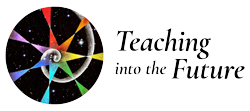I have been brainstorming what it means to hold space for students in a way that is authentic and real. We hold space for others when we hold space for ourselves would always have to come from our own inner authenticity and our own ability to work in our lives. On that note, when I first became a teacher, I was a Waldorf teacher. I got into the practice of saying a verse or a meditation before the day started by putting the cloak of my own personal life, the concerns of my family, the needs of others in a way that was not related to the classroom at the door.
I picked up the professional hat that every teacher picks up when they come into their classroom before they open the door to the students. To help me do that, I found that a meditation or a poem was absolutely essential in pulling me into that necessary mindset. By working with the power of poetry, we remember what it means to be human, and it gives us the courage that other people have walked the path and talked the talk that we are talking and that we are aiming for in a way of working with meaningful social change.
A book that came my way is Teaching with Fire: Poetry That Sustains the Courage to Teach. I’d like to share a passage from a poem:
Look at Anything by John Moffitt:
“To look at anything, if you would know that thing, you must look at it long to look at this screen and say I have seen spring in these woods will not do. You must be the thing. You see, you must be the dark snakes of stems and ferney plumes of leaves. You must enter into the small silences between the leaves. You must take your time and touch the very piece they issue from.”
Another objective I made was to take a moment of silence just to myself before I opened the door, and ask this question, how do I reach my students today?
What do I need to listen to? It was just done as an open ended reflection or meditation in the morning. It was interesting because for many years I knew where my students were coming from. I knew their home environment and often knew their parents. It was a tight knit school. However, as I went on to work with the homeschooling organization called Self Design High, I did not know so much about my students and I had too many students to know everything about them from grade 10 to grade 12. However it is imperative to know where our students are coming from and what their home environment is. If I did not know, I needed to remember to ask because that is when we hold space for our students. We
offer ourselves to be a container for this experience that they are having of us and their experience they are having of school. The more centered and grounded, we are inside of ourselves the better. It is as if our steadiness allows our students to lean into us for support, and our quiet presence can provide an environment in which they can be free to think, to live and to move to do this.
In the past I have talked about working with Earth, Air, Fire and Water, but really it gave me that picture of when do they need me to be a rock and when do they need me to be air? When do they need me to be more enthusiastic and more like fire and how do I be water for them so I can flow past their own anxieties? We can help our students by being responsive to them, not by first being ourselves, but leaving our cloak of ourselves at the doors, I said, and moving into being any one of the four elements being what they need us to be. By being aware and open, this level of holding space requires humility and conscientiousness. It is an ability to step out of the way. For us to honestly understand that this is not about us, our lesson or our goals for the students, it is about acknowledging our connections and how close we all are as human beings. Instead of working with what separates us, teacher, student, school, home, learning the known and the unknown, what I know what they do not, all of those separations can leave a gulf between ourselves and our students. Working with the connections and how close we all are works with the sense of belonging, which we all need, want and love. I began to see that every student that we meet and learn from and connect with is part of our human family.
Most teachers are adept at seeing the big picture. We have got our unit block plan, our main lesson, whatever you call it. We have got our big goals, the big idea behind the practice of education. We can get caught up in the hectic pace of all of that, of assessments, of reports of delivery. We feel compelled in a way to immediately distinguish what is important and what is not important. That assessment is an easy one to make when we are mired in the daily grind of our classrooms, our school life or our home environment, if you are a homeschooling parent. However, everything related to student success seems significant and everything else seems comparatively trivial. In the end I realize that what is most precious in this life, in our classrooms and in our hearts cannot be measured in success or influence. The most noteworthy events in our classrooms are often the least seen or the least momentous, and yet they can be the most meaningful. They are the magical moments in which we are connecting with our students through inquiry, personalized assistance or having a light bulb moment in the classroom, which can be spontaneous. To experience those fully, we need to open ourselves to their existence. These moments are not measured by what goes into it as a recipe, but rather by our actions and reactions to it. Since these moments come and go really quickly, they need to be noted and savored and they stick with us when we recognize the impact they have had on our mood and our day and our lives. In recognizing such moments, we find that we have evolved a little bit as people and that our students have also evolved around us and more have changed in some positive way.
I think of someone I know in Vancouver, British Columbia, who is a teacher, librarian in one of the largest high schools in the city, and she told me a story a number of months ago about a student in the school who has a behavioral designation and was a spinner. He could not sit at a desk and he constantly twirled himself into a spin, often resulting in his removal from all the classes to the library. After some time in the library, Denise began to see past his belligerent attitude and classroom behavior. She thought his level of intelligence was off the chart, but he did not have a gifted designation. She began the process cooperatively with the vice principal to have him tested for gifted status. She told me that he came out in the 99 percentile. Holding space for this student did not stop there, however.
I called her today to review the story that she told me in the fall, and she said that she went to visit him at his home last week.

